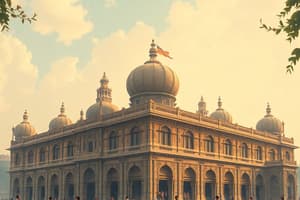Podcast
Questions and Answers
What primarily composed the Mughal army?
What primarily composed the Mughal army?
- War elephants
- Cavalry and infantry (correct)
- Naval forces
- Artillery units
The Collectorate was previously considered a center of military strength.
The Collectorate was previously considered a center of military strength.
False (B)
What name is given to the foot soldiers in the Mughal army?
What name is given to the foot soldiers in the Mughal army?
Paidal
In the name of __________, power and patronage steadily replaced previous holders of authority.
In the name of __________, power and patronage steadily replaced previous holders of authority.
What change occurred in the eighteenth century concerning the Mughal successor states?
What change occurred in the eighteenth century concerning the Mughal successor states?
The Mughal military strategy relied heavily on professional soldiers.
The Mughal military strategy relied heavily on professional soldiers.
What training was provided to Mughals' infantry soldiers?
What training was provided to Mughals' infantry soldiers?
The rural areas had a large number of armed __________ who contributed to the Mughal army.
The rural areas had a large number of armed __________ who contributed to the Mughal army.
Match the following terms with their descriptions:
Match the following terms with their descriptions:
What was a primary feature of colonial rule in India?
What was a primary feature of colonial rule in India?
Flashcards are hidden until you start studying
Study Notes
East India Company Trade in Bengal
- The first English factory was established in 1651 on the Hugli River, serving as the primary trading base for the East India Company.
- Traders, initially referred to as "factors," utilized the factory's warehouse for storing export goods and offices for administrative purposes.
- The Company's presence encouraged merchants to settle nearby, leading to the construction of a fort around the settlement by 1696.
- In 1698, the Company obtained zamindari rights over three villages, including Kalikata, which later developed into Calcutta (now Kolkata).
- A significant farman (royal edict) from Mughal emperor Aurangzeb permitted the Company to trade duty-free, although it faced criticism for evading duties on private trade.
- Nawab Murshid Quli Khan protested against the Company's refusal to pay duties, highlighting the financial loss for Bengal due to the Company's actions.
Expansionist Policies and Conflict
- The Company's strategy involved manipulating local rulers rather than direct territorial conquest, initially aiming for trade expansion without military intervention.
- Conflicts emerged when puppet nawabs like Mir Jafar were deposed for not complying with the Company's demands. Mir Jafar was replaced by Mir Qasim, who was later defeated in the Battle of Buxar (1764).
- The East India Company transitioned to greater political control over Bengal, impacting local governance and authority.
War with the Marathas
- The East India Company targeted Maratha power from the late 18th century, following the Marathas' defeat in the Third Battle of Panipat (1761), which fragmented their control.
- The Maratha Confederacy comprised various chiefs under a central Peshwa, with notable figures like Mahadji Sindhia and Nana Phadnis leading them.
- The Company clashed with these chiefs, leading to a series of conflicts, including the first war ending in 1782 with the inconclusive Treaty of Salbai.
Colonial Military Structure
- Colonial rule introduced new administrative concepts but was heavily reliant on military strength.
- The Mughal army, predominantly comprised of cavalry and a lesser infantry, faced challenges in adapting to changing military strategies during the 18th century.
- The emergence of successor states like Awadh and Banaras marked a shift toward recruiting and training peasant soldiers for broader military engagement.
Studying That Suits You
Use AI to generate personalized quizzes and flashcards to suit your learning preferences.




